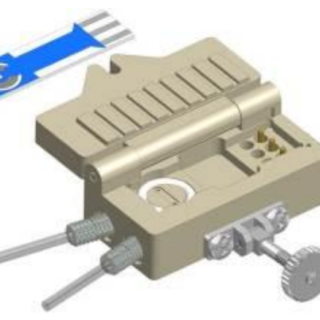Category
- CUSTOMER SERVICES
- NEW PRODUCTS
- Sensors and electrodes
- Custom made and Modified Screen Printed Electrodes
- Stirrers
- Cables and connectors
- Cell
- Potentiostats
- Manual Screen Printer
- Minithermostat
- Pumps
- Accessories
- Kits & Sets
- Discounted SPEs (at a reduced price with visual defects/inconsistancies, but fully functional)
PME011 Microdialysis Catheter Microeye
Microdialysis catheter is provided with a special membrane which produces a “plasma-like” sample without the need for blood centrifugation.
It enables “plasma-like” samples taking and continuous monitoring of low-molecular substances in circulating blood without withdrawing blood from the patient. It offers virtually real-time information. Samples can be collected for off-line analysis if required. This catheter is easy to use and reduces risks of contact with blood borne pathogens. The MicroEye is intended for intravenous use for periods up to 48 hours and is inserted via 18G blood catheter.
The range of substances that can be monitored using this catheter
- Electrolytes (such as potassium, magnesium etc.)
- Energy metabolites (glucose, lactate, pyruvate, etc.)
- Amino acids (glutamate, GABA, etc.)
- Hormones and neurotransmitters (dopamine, serotonin, etc.)
- Inflammatory mediators and growth factors (cytokines, etc.)
- Drugs and their metabolites (unbound “free fractions and /or total
You may also like…
-
MDC1 Microdialysis Catheter for “in vitro” Measurement
Read moreThe microflow cell FC2 (BVT Technologies, a.s.) connected with microdialysis catheter PME011 (Probe Scientific, Ltd., UK) enables continuous monitoring of low-molecular substances in circulating blood without withdrawing blood from the tested body. (The device is not approved for human use as a whole; the microdialysis catheter has the approval for medical use).
SPE electrochemical sensors and biosensors can be enclosed in the FC2 cell – e.g. the AC1.GOD sensor for measuring glucose. The advantage of this system is the defined and sterile conditions under which the sample is fed through the microdialysis catheter to the working electrode of the SPE sensor.
The device can be also used for measurement in fermentation reactors, in subcutaneous tissues or in special scientific apparatuses. The main advantage of this catheter is in a special membrane which produces a “plasma-like” or “prefiltered sample” sample without the need for blood centrifugation or deproteinization.
MDC1 makes online monitoring of different blood parameters (biochemical compounds actual concentration or kinetics of enzymatic reactions) possible. The device is also convenient for pharmacological studies. The device can be used only for non human applications.
-
FC2.TL.* PMMA Flow Cell
Read moreThe flow cell enables the use of Screen printed sensors in a flow through arrangement.
The flow cell is suitable for sensors of type AC1, AC2, CC1, CC2 and CC3.
The Screen printed sensor is inserted into the slit of cell and tightened by closing of the door. The cell ensures the wall-jet flow around the working electrode and it is optimised so that no air bubbles cumulate in the cell. The cell contains also the contact and output cable.
With the sensors enclosed in a flow cell, it is possible to measure semi-automatically or automatically using a pump or liquid switch for sample supply. Under such conditions, maximum measurement reproducibility is ensured.
-
2PP.T Dual Channel Peristaltic Pump
Read moreThe peristaltic pump 2PP.T* is simple device for routine laboratory use. The pump has two channels. The flow is in one direction.
The lifetime of tubing is optimized to maximal value. The pulsation is minimized for flow cell FC2.
The integrated shaft enables fastening by standard laboratory clamps. The pump is supplied by max 12V. The rotation speed is controlled by voltage. The control unit is delivered with pump.
The force on the tubing is adjusted by screw a spring. The pulsation damper can be ordered separately.
-
FC4.TL.* PEEK Flow Cell
Read moreThe FC4.TL flow cell is made of PEEK and enables the use of Screen printed sensors in a flow through arrangement.
It has teflon endings permitting a fully compatible connection to chromatography tubing.
The flow cell is suitable for sensors of type AC1, AC2, CC1, CC2 and CC3.
The Screen printed sensor is inserted into the slit of cell and tightened by closing of the door. The cell ensures the wall-jet flow around the working electrode and it is optimised so that no air bubbles cumulate in the cell. The cell contains also the contact and output cable.
With the sensors enclosed in a flow cell, it is possible to measure semi-automatically or automatically using a pump or liquid switch for sample supply. Under such conditions, maximum measurement reproducibility is ensured.
Related products
-
Pipette Round Base Stand
Read moreA custom BVT pipette stand with a round base, designed for storing a large number of glass pipettes. Made to be robust and long-lasting, for easy organization, storage and use.
The round stand contains 35 holes with a diameter of 11.38 mm and 14 holes with
a diameter of 7.89 mm.The stand is designed so that the lower round base of the stand can be separated from the stand for easy washing.
-
Activation furnance for electrochemical sensors
Read moreThe activation furnance is a device used for curing individual sensors of the AC1 type. At a defined temperature (up to 1000 °C) depending on the electrode and sensor materials. When the sensor is cured, the surface of the electrodes is cleaned from surface oxides and organic impurities, which results in regeneration of the sensor or its activation. In this way, for example, old sensors with immobilized enzyme layers can be cured for reuse – see example at the end ot the document.










